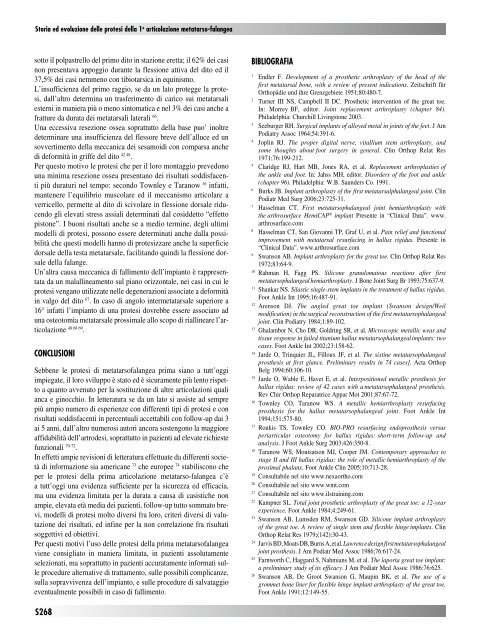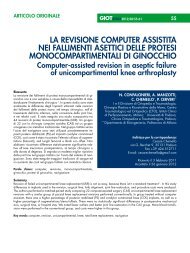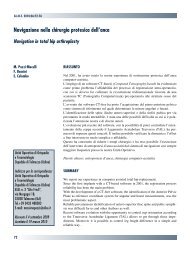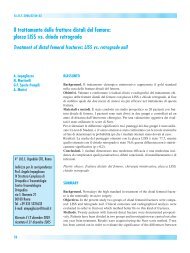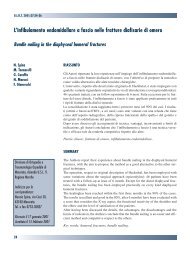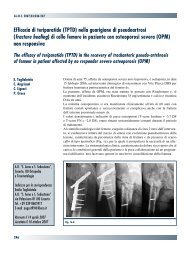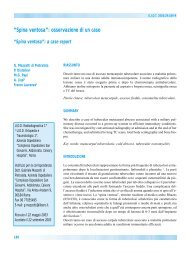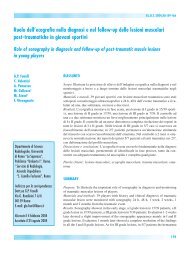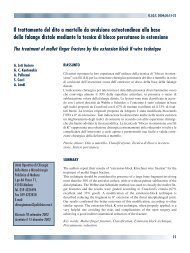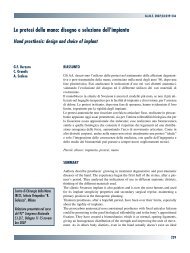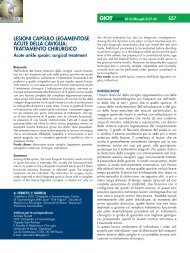30845 Suppl Giot.pdf - Giornale Italiano di Ortopedia e Traumatologia
30845 Suppl Giot.pdf - Giornale Italiano di Ortopedia e Traumatologia
30845 Suppl Giot.pdf - Giornale Italiano di Ortopedia e Traumatologia
You also want an ePaper? Increase the reach of your titles
YUMPU automatically turns print PDFs into web optimized ePapers that Google loves.
Storia ed evoluzione delle protesi della 1 a articolazione metatarso-falangea<br />
sotto il polpastrello del primo <strong>di</strong>to in stazione eretta; il 62% dei casi<br />
non presentava appoggio durante la flessione attiva del <strong>di</strong>to ed il<br />
37,5% dei casi nemmeno con tibiotarsica in equinismo.<br />
L’insufficienza del primo raggio, se da un lato protegge la protesi,<br />
dall’altro determina un trasferimento <strong>di</strong> carico sui metatarsali<br />
esterni in maniera più o meno sintomatica e nel 3% dei casi anche a<br />
fratture da durata dei metatarsali laterali 66 .<br />
Una eccessiva resezione ossea soprattutto della base puo’ inoltre<br />
determinare una insufficienza del flessore breve dell’alluce ed un<br />
sovvertimento della meccanica dei sesamoi<strong>di</strong> con comparsa anche<br />
<strong>di</strong> deformità in griffe del <strong>di</strong>to 42 48 .<br />
Per questo motivo le protesi che per il loro montaggio prevedono<br />
una minima resezione ossea presentano dei risultati sod<strong>di</strong>sfacenti<br />
più duraturi nel tempo: secondo Townley e Taranow 16 infatti,<br />
mantenere l’equilibrio muscolare ed il meccanismo articolare a<br />
verricello, permette al <strong>di</strong>to <strong>di</strong> scivolare in flessione dorsale riducendo<br />
gli elevati stress assiali determinati dal cosiddetto “effetto<br />
pistone”. I buoni risultati anche se a me<strong>di</strong>o termine, degli ultimi<br />
modelli <strong>di</strong> protesi, possono essere determinati anche dalla possibilità<br />
che questi modelli hanno <strong>di</strong> protesizzare anche la superficie<br />
dorsale della testa metatarsale, facilitando quin<strong>di</strong> la flessione dorsale<br />
della falange.<br />
Un’altra causa meccanica <strong>di</strong> fallimento dell’impianto è rappresentata<br />
da un malallineamento sul piano orizzontale, nei casi in cui le<br />
protesi vengano utilizzate nelle degenerazioni associate a deformità<br />
in valgo del <strong>di</strong>to 67 . In caso <strong>di</strong> angolo intermetatarsale superiore a<br />
16° infatti l’impianto <strong>di</strong> una protesi dovrebbe essere associato ad<br />
una osteotomia metatarsale prossimale allo scopo <strong>di</strong> riallineare l’articolazione<br />
48 68 69 .<br />
CONCLuSIONI<br />
Sebbene le protesi <strong>di</strong> metatarsofalangea prima siano a tutt’oggi<br />
impiegate, il loro sviluppo è stato ed è sicuramente più lento rispetto<br />
a quanto avvenuto per la sostituzione <strong>di</strong> altre articolazioni quali<br />
anca e ginocchio. In letteratura se da un lato si assiste ad sempre<br />
più ampio numero <strong>di</strong> esperienze con <strong>di</strong>fferenti tipi <strong>di</strong> protesi e con<br />
risultati sod<strong>di</strong>sfacenti in percentuali accettabili con follow-up dai 3<br />
ai 5 anni, dall’altro numerosi autori ancora sostengono la maggiore<br />
affidabilità dell’artrodesi, soprattutto in pazienti ad elevate richieste<br />
funzionali 70-72 .<br />
In effetti ampie revisioni <strong>di</strong> letteratura effettuate da <strong>di</strong>fferenti società<br />
<strong>di</strong> informazione sia americane 73 che europee 74 stabiliscono che<br />
per le protesi della prima articolazione metatarso-falangea c’è<br />
a tutt’oggi una evidenza sufficiente per la sicurezza ed efficacia,<br />
ma una evidenza limitata per la durata a causa <strong>di</strong> casistiche non<br />
ampie, elevata età me<strong>di</strong>a dei pazienti, follow-up tutto sommato brevi,<br />
modelli <strong>di</strong> protesi molto <strong>di</strong>versi fra loro, criteri <strong>di</strong>versi <strong>di</strong> valutazione<br />
dei risultati, ed infine per la non correlazione fra risultati<br />
soggettivi ed obiettivi.<br />
Per questi motivi l’uso delle protesi della prima metatarsofalangea<br />
viene consigliato in maniera limitata, in pazienti assolutamente<br />
selezionati, ma soprattutto in pazienti accuratamente informati sulle<br />
procedure alternative <strong>di</strong> trattamento, sulle possibili complicanze,<br />
sulla sopravvivenza dell’impianto, e sulle procedure <strong>di</strong> salvataggio<br />
eventualmente possibili in caso <strong>di</strong> fallimento.<br />
S268<br />
BIBLIOGraFIa<br />
1 Endler F. Development of a prosthetic arthroplasty of the head of the<br />
first metatarsal bone, with a review of present in<strong>di</strong>cations. Zeitschrift für<br />
Orthopä<strong>di</strong>e und ihre Grenzgebiete 1951;80:480-7.<br />
2 Turner III NS, Campbell II DC. Prosthetic intervention of the great toe.<br />
In: Morrey BF, e<strong>di</strong>tor. Joint replacement arthroplasty (chapter 84).<br />
Philadelphia: Churchill Livingstone 2003.<br />
3 Seeburger RH. Surgical implants of alloyed metal in joints of the feet. J Am<br />
Po<strong>di</strong>atry Assoc 1964;54:391-6.<br />
4 Joplin RJ. The proper <strong>di</strong>gital nerve, vitallium stem arthroplasty, and<br />
some thoughts about foot surgery in general. Clin Orthop Relat Res<br />
1971;76:199-212.<br />
5 Claridge RJ, Hart MB, Jones RA, et al. Replacement arthroplasties of<br />
the ankle and foot. In: Jahss MH, e<strong>di</strong>tor. Disorders of the foot and ankle<br />
(chapter 96). Philadelphia: W.B. Saunders Co. 1991.<br />
6 Burks JB. Implant arthroplasty of the first metatarsalphalangeal joint. Clin<br />
Po<strong>di</strong>atr Med Surg 2006;23:725-31.<br />
7 Hasselman CT. First metatarsophalangeal joint hemiarthroplasty with<br />
the arthrosurface HemiCAP ® implant Presente in “Clinical Data”. www.<br />
arthrosurface.com<br />
8 Hasselman CT, San Giovanni TP, Graf U, et al. Pain relief and functional<br />
improvement with metatarsal resurfacing in hallux rigidus. Presente in<br />
“Clinical Data”. www.arthrosurface.com<br />
9 Swanson AB. Implant arthroplasty for the great toe. Clin Orthop Relat Res<br />
1972;83:64-9.<br />
10 Rahman H, Fagg PS. Silicone granulomatous reactions after first<br />
metatarsophalangeal hemiarthroplasty. J Bone Joint Surg Br 1993;75:637-9.<br />
11 Shankar NS. Silastic single-stem implants in the treatment of hallux rigidus.<br />
Foot Ankle Int 1995;16:487-91.<br />
12 Arenson DJ. The angled great toe implant (Swanson design/Weil<br />
mo<strong>di</strong>fication) in the surgical reconstruction of the first metatarsophalangeal<br />
joint. Clin Po<strong>di</strong>atry 1984;1:89-102.<br />
13 Ghalambor N, Cho DR, Goldring SR, et al. Microscopic metallic wear and<br />
tissue response in failed titanium hallux metatarsophalangeal implants: two<br />
cases. Foot Ankle Int 2002;23:158-62.<br />
14 Jarde O, Trinquier JL, Filloux JF, et al. The sixtine metatarsophalangeal<br />
prosthesis at first glance. Preliminary results in 74 cases]. Acta Orthop<br />
Belg 1994;60:106-10.<br />
15 Jarde O, Wable E, Havet E, et al. Interpositioned metallic prosthesis for<br />
hallux rigidus: review of 42 cases with a metatarsophalangeal prosthesis.<br />
Rev Chir Orthop Reparatrice Appar Mot 2001;87:67-72.<br />
16 Townley CO, Taranow WS. A metallic hemiarthroplasty resurfacing<br />
prosthesis for the hallux metatarsophalangeal joint. Foot Ankle Int<br />
1994;151:575-80.<br />
17 Roukis TS, Townley CO. BIO-PRO resurfacing endoprosthesis versus<br />
periarticular osteotomy for hallux rigidus: short-term follow-up and<br />
analysis. J Foot Ankle Surg 2003;426:350-8.<br />
18 Taranow WS, Moutsatson MJ, Cooper JM. Contemporary approaches to<br />
stage II and III hallux rigidus: the role of metallic hemiarthroplasty of the<br />
proximal phalanx. Foot Ankle Clin 2005;10:713-28.<br />
19 Consultabile nel sito www.nexaortho.com<br />
20 Consultabile nel sito www.wmt.com<br />
21 Consultabile nel sito www.ilstraining.com<br />
22 Kampner SL. Total joint prosthetic arthroplasty of the great toe: a 12-year<br />
experience. Foot Ankle 1984;4:249-61.<br />
23 Swanson AB, Lumsden RM, Swanson GD. Silicone implant arthroplasty<br />
of the great toe. A review of single stem and flexible hinge implants. Clin<br />
Orthop Relat Res 1979;(142):30-43.<br />
24 Jarvis BD, Moats DB, Burns A, et al. Lawrence design first metatarsophalangeal<br />
joint prosthesis. J Am Po<strong>di</strong>atr Med Assoc 1986;76:617-24.<br />
25 Farnworth C, Haggard S, Nahmians M, et al. The laporta great toe implant:<br />
a preliminary study of its efficacy. J Am Po<strong>di</strong>atr Med Assoc 1986:76:625.<br />
26 Swanson AB, De Groot Swanson G, Maupin BK, et al. The use of a<br />
grommet bone liner for flexible hinge implant arthroplasty of the great toe.<br />
Foot Ankle 1991;12:149-55.


